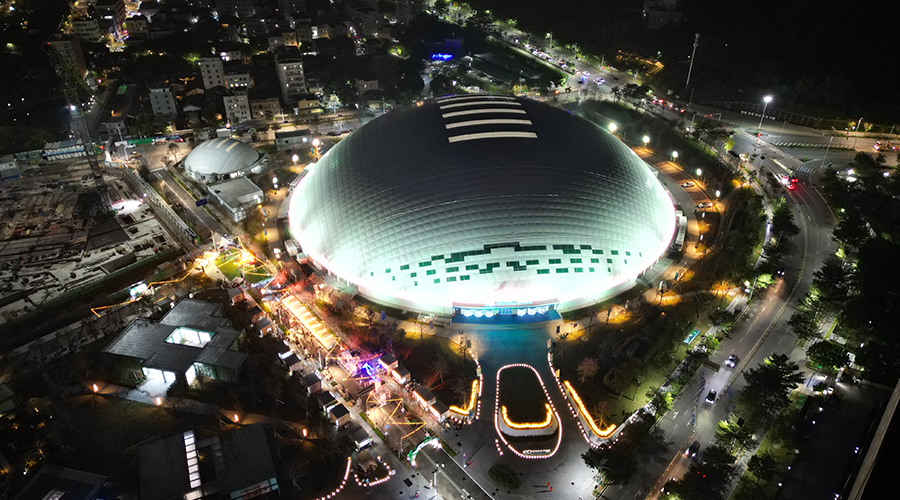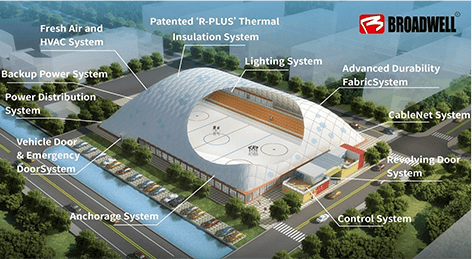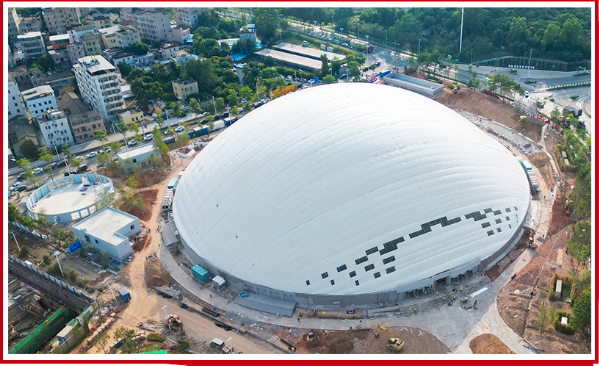Welcome to the world of Air Domes—a fusion of modern architecture and sports innovation. This guide navigates the fundamentals, applications, and perks of Air Domes. From their inflatable materials to practical applications in sports, recreation, and industry, we'll break down the essentials.

What is An Air Dome
An Air Dome, in architectural terms, is a versatile structure employing inflatable materials to create a covered space. Comprising a framework of support, the dome gains its structure through the inflation of these materials, offering a unique blend of flexibility and strength. This innovative design finds application across various domains, primarily in sports facilities like tennis courts, soccer fields, and golf courses. The inflatable nature of Air Domes provides cost-efficient solutions compared to traditional construction methods.
How Do Air Domes Work?
The working principle of Air Domes involves the strategic use of inflatable materials, support systems, and advanced control mechanisms. This combination not only ensures structural integrity but also provides a level of adaptability and environmental control that makes Air Domes a modern and efficient solution for diverse architectural and recreational needs. Here is how air domes work:

Air Pressure
Air Domes stay strong thanks to high-pressure air inside their roofs. This pressure creates a powerful upward force, supporting the roof's weight and making the whole structure stable. When the roof material gets filled with air, it becomes tight and strong, giving the dome its shape. The smart use of air pressure makes Air Domes adaptable to different conditions, like handling heavy snow or keeping a steady climate inside. So, it's not just air; it's the carefully controlled air pressure that makes Air Domes sturdy and versatile.
Frame Structure
Air Domes rely on specific structural components to achieve their inflatable and resilient nature. The primary material used is often a reinforced fabric or PVC, chosen for its durability and ability to withstand the forces exerted during inflation. This fabric undergoes careful engineering to provide both flexibility and strength. Additionally, the seams and joints are reinforced to ensure airtightness and maintain the integrity of the structure.
Air Tightness
For an Air Dome to work effectively, it must be airtight to keep the desired air pressure steady. The roof plays a pivotal role, made from robust and flexible materials like PVDF or PVF. These materials are strong enough to withstand the internal air pressure, ensuring the dome remains stable and retains its shape. The combination of an airtight design and durable roof material is essential for maintaining the structural integrity of the Air Dome, making it a reliable and long-lasting architectural solution.
Ventilation
To keep things comfortable inside, Air Domes need ventilation. Vents and fans play a crucial role by allowing air to move in and out of the dome. This exchange helps control the temperature, humidity, and air quality inside. Imagine it like the dome taking a breath to make sure the people inside stay comfortable and the environment stays just right. So, ventilation is a key part of how Air Domes create a pleasant indoor atmosphere.
Advantages of Air Domes
Air Domes offer a host of advantages that position them as a pragmatic and efficient solution across various applications. Here's a straightforward exploration of these benefits:
Fast Installation and Cost Efficiency
Setting up an air dome is way more time-saving than building a concrete building. All the membranes and steel materials are pre-built in the factories, so the installation time is reduced by almost 50%. Traditional construction methods can be notably expensive and time-consuming. In contrast, the materials used in Air Domes, like reinforced fabric or PVC, are cost-effective, contributing to overall project affordability. Additionally, the streamlined construction process significantly reduces both labor and time requirements.
Versatile Design
Versatility in design stands out as another key advantage. The inflatable nature of Air Domes allows for a wide range of shapes and sizes, offering architects and designers greater flexibility in realizing diverse spatial requirements. This adaptability extends to the reusability of Air Domes. Their modular and portable nature facilitates dismantling and relocation, making them suitable for temporary installations or events.
Environmental Sustainability
Environmental sustainability is a notable consideration. The materials used in Air Domes are often recyclable, aligning with contemporary environmental standards. Furthermore, the controlled inflation and deflation mechanisms enable efficient energy use, reducing the overall environmental footprint compared to traditional, more energy-intensive construction methods.
Applications of Air Domes
Air Domes find diverse applications, demonstrating their adaptability and functionality across various domains.
-
Sports Facilities: Enabling year-round usability for tennis courts, soccer fields, and golf courses, ensuring consistent training and competition regardless of weather conditions. Learn more about sports application.
-
Recreation: Serving as versatile event venues and amusement park enclosures, providing controlled environments for enhanced visitor experiences.
-
Industrial Use: Offering practical solutions in warehousing and construction, providing cost-effective shelter for materials and equipment, and adapting to different construction site requirements.
-
Emergency Relief: Facilitating quick and portable shelter solutions for emergency and disaster relief operations.
The applications of Air Domes span sports, recreation, industry, and emergency response. Their versatility and adaptability underscore their value across diverse settings, showcasing how these inflatable structures have become integral in reshaping the functionality of various spaces.
How to Choose Air Domes
Selecting the right Air Dome involves a thoughtful evaluation of several key considerations to ensure optimal functionality and satisfaction.
Budgetary Considerations
One primary consideration is the financial aspect. Assessing the budget for the Air Dome project involves not only the initial construction costs but also long-term maintenance expenses. While Air Domes are generally cost-effective compared to traditional structures, a clear understanding of the financial commitment is essential.
Climate and Location Factors
The geographical location significantly influences the performance of an Air Dome. Different climates pose varying challenges, such as heavy snow loads, extreme temperatures, or high winds. Evaluating the specific climate conditions of the intended location ensures the selection of an Air Dome that can withstand and adapt to these challenges effectively.
Purpose and Intended Use
Defining the purpose and intended use of the Air Dome is critical. Whether it's for sports, recreation, industrial storage, or emergency relief, each application comes with unique requirements. Tailoring the design and specifications of the Air Dome to align with its intended use guarantees optimal performance and longevity.
Broadwell: Professional Air Domes Supplier
Broadwell stands as a globally recognized leader in the field of air dome manufacturing, boasting an impressive portfolio that includes over 300 successfully crafted structures. We are the only one in the world of all the air dome supplier has air dome R&D center and the world’s largest manufacturing center. Our business covers China, Russia, North America, the Middle East, Japan, South Korea, Southeast Asia, etc. We have many cases including Miami Little Prince Air Dome Laser Show, ENS MBZ BOYS School-Air Dome Stadium Project and etc.
Contact us now to explore how Broadwell can elevate your vision, providing tailored air dome solutions that redefine the possibilities for sports, recreation, industry, and beyond. Your journey to a state-of-the-art air dome begins with Metaspace—where excellence meets innovation.










